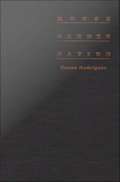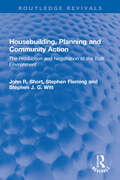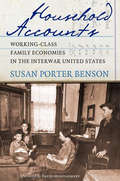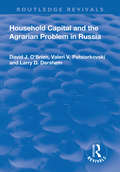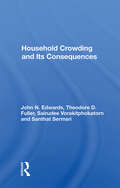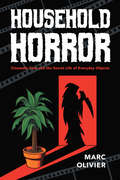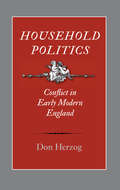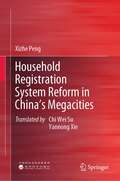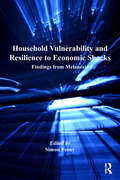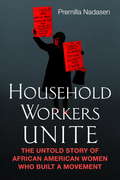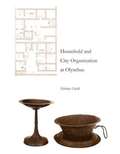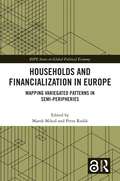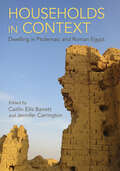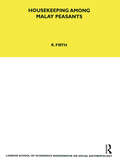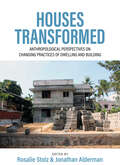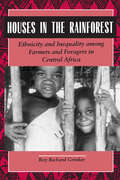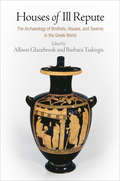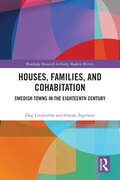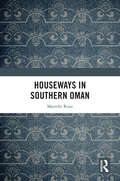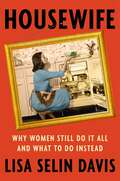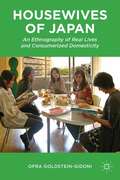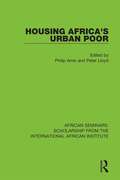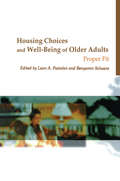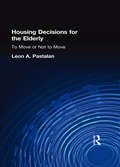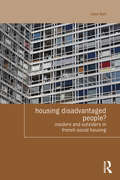- Table View
- List View
House/Garden/Nation: Space, Gender, and Ethnicity in Postcolonial Latin American Literatures By Women
by Ileana Rodríguez Ileana Rodríguez Robert CarrHow ironic, the author thought on learning of the Sandinista's electoral defeat, that at its death the Revolutionary State left Woman, Violeta Chamorro, located at the center. The election signaled the end of one transition and the beginning of another, with Woman somewhere on the border between the neo-liberal and marxist projects. It is such transitions that Ileana Rodrguez takes up here, unraveling their weave of gender, ethnicity, and nation as it is revealed in literature written by women. In House/Garden/Nation the narratives of five Centro-Caribbean writers illustrate these times of transition: Dulce Mara Loynz, from colonial rule to independence in Cuba; Jean Rhys, from colony to commonwealth in Dominica; Simone Schwarz-Bart, from slave to free labor in Guadeloupe; Gioconda Belli, from oligarchic capitalism to social democratic socialism in Nicaragua; and Teresa de la Parra, from independence to modernity in Venezuela. Focusing on the nation as garden, hacienda, or plantation, Rodrguez shows us these writers debating the predicament of women under nation formation from within the confines of marriage and home. In reading these post-colonial literatures by women facing the crisis of transition, this study highlights urgent questions of destitution, migration, exile, and inexperience, but also networks of value allotted to women: beauty, clothing, love. As a counterpoint on issues of legality, policy, and marriage, Rodriguez includes a chapter on male writers: Jos Eustacio Rivera, Omar Cabezas, and Romulo Gallegos. Her work presents a sobering picture of women at a crossroads, continually circumscribed by history and culture, writing their way.
Housebuilding, Planning and Community Action: The Production and Negotiation of the Built Environment (Routledge Revivals)
by Stephen Fleming John R. Short Stephen J. WittFirst published in 1986, Housebuilding, Planning and Community Action was written as an examination of the conflicts and tensions resulting from private sector housing growth in Central Berkshire, part of Britain’s ‘Silicon Valley’ along the M4 motorway. The book provides a detailed consideration of the various ‘actors’ and their interactions and explores the fight from Community groups and parish councils to halt development, in opposition to the government’s reluctance to discourage economic growth. It focuses on four groups closely involved in the production, allocation, and consumption of new housing: speculative housebuilders, local planning authorities, parish councils, and community/residents’ groups. The motivations and actions of each group are examined, and the tensions between them are highlighted, set within the context of central government attitudes towards planning and private housebuilding. Housebuilding, Planning and Community Action has lasting relevance for those interested in human geography, and the history of housebuilding and planning.
Household Accounts: Working-Class Family Economies in the Interwar United States
by David Montgomery Susan Porter BensonWith unprecedented subtlety, compassion and richness of detail, Susan Porter Benson takes readers into the budgets and the lives of working-class families in the United States between the two world wars. Focusing on families from regions across America and of differing races and ethnicities, she argues that working-class families of the time were not on the verge of entering the middle class and embracing mass culture. Rather, she contends that during the interwar period such families lived in a context of scarcity and limited resources, not plenty. Their consumption, Benson argues, revolved around hard choices about basic needs and provided therapeutic satisfactions only secondarily, if at all. Household Accounts is rich with details Benson gathered from previously untapped sources, particularly interviews with women wage earners conducted by field agents of the Women's Bureau of the Department of Labor. She provides a vivid picture of a working-class culture of family consumption: how working-class families negotiated funds; how they made qualitative decisions about what they wanted; how they determined financial strategies and individual goals; and how, in short, families made ends meet during this period. Topics usually central to the histories of consumption--he development of mass consumer culture, the hegemony of middle-class versions of consumption, and the expanded offerings of the marketplace--contributed to but did not control the lives of working-class people. Ultimately, Household Accounts seriously calls into question the usual narrative of a rising and inclusive tide of twentieth-century consumption.
Household Capital and the Agrarian Problem in Russia
by David J O'Brien Valeri V Patsiorkovski Larry D DershemThis title was first published in 2000: Using micro-level data, this text shows that rural Russian households have made significant adaptations to an emerging market economy in just a few years. It focuses on how household capital (household labour, social networks and comunity attachment) effect the economic and psychological adaptation of households to rapid socioeconomic change. Findings are from 1995 to 1997 panel surveys made in three waves. The book deals systematically with micro-level processes of household adaptation to a market economy, institutional change and emerging informal and formal patterns of land tenure and use in Russia. It shows how structural changes are occurring in rural Russia and their impact on household enterprise development and income. Difference in household capital explains the emergence of inequality in the countryside and differences in the degree to which households experience stress and a higher or lower subjective quality of life.
Household Crowding And Its Consequences
by John EdwardsThis book examines the social and psychological impact of household congestion in the context typical of the developing world on psychological wellbeing, marital and family relations, sibling relations, violence within the family, the impact on marital sex and reproductive behavior.
Household Horror: Cinematic Fear and the Secret Life of Everyday Objects (The\year's Work: Studies In Fan Culture And Cultural Theory Ser.)
by Marc OlivierA scholar examines 14 everyday objects featured in horror films and how they manifest their power and speak to society’s fears.Take a tour of the house where a microwave killed a gremlin, a typewriter made Jack a dull boy, a sewing machine fashioned Carrie’s prom dress, and houseplants might kill you while you sleep. In Household Horror, Marc Olivier highlights the wonder, fear, and terrifying dimension of objects in horror cinema. Inspired by object-oriented ontology and the nonhuman turn in philosophy, Olivier places objects in film on par with humans, arguing, for example, that a sleeper sofa is as much the star of Sisters as Margot Kidder, that The Exorcist is about a possessed bed, and that Rosemary’s Baby is a conflict between herbal shakes and prenatal vitamins. Household Horror reinvigorates horror film criticism by investigating the unfathomable being of objects as seemingly benign as remotes, radiators, refrigerators, and dining tables. Olivier questions what Hitchcock’s Psycho tells us about shower curtains. What can we learn from Freddie Krueger’s greatest accomplice, the mattress? Room by room, Olivier considers the dark side of fourteen household objects to demonstrate how the objects in these films manifest their own power and connect with specific cultural fears and concerns.“Provides a lively and highly original contribution to horror studies. As a work on cinema, it introduces the reader to films that may be less well-known to casual fans and scholars; more conspicuously, it returns to horror staples, gleefully reanimating works that one might otherwise assume had been critically “done to death” (Psycho, The Exorcist, The Shining).” —Allan Cameron, University of Auckland
Household Politics
by Don HerzogEarly modern English canonical sources and sermons often urge the subordination of women. In Household Politics, Don Herzog argues that these sources were blatherâ "not that they were irrelevant, but that plenty of people rolled their eyes at them. Indeed many held that a man had to be an idiot or a buffoon to try to act on their hoary â œwisdom.â ? Households didnâ TMt bask serenely in naturalized or essentialized patriarchy. Instead, husbands, wives, and servants struggled endlessly over authority. Nor did some insidiously gendered public/private distinction make the political subordination of women invisible. Conflict, Herzog argues, doesn't corrode social order: it's what social order usually consists in. He uses the argument to impeach conservatives and their radical critics for sharing confused alternatives. The social world Herzog brings vibrantly alive is much richerâ "and much pricklierâ "than many imagine.
Household Registration System Reform in China's Megacities
by Xizhe PengThis book examines the impact of population growth and urbanization on the household registration system in China. Drawing on experiences from other countries in population management, it proposes a general framework for reforming the household registration system in China. This framework is based on the principle of "equity of rights and obligations" and includes a points system to guide implementation. The book also analyzes the economic implications of optimizing restrictions on urban household registration and the fiscal reforms associated with the reform. The practicality of the points system program is further verified.
Household Vulnerability and Resilience to Economic Shocks: Findings from Melanesia (Economic Geography Series)
by Simon FeenyFocusing on the vulnerability and resilience to economic shocks at the household level, this book draws on extensive research activities carried out in two Melanesia countries: the Solomon Islands and Vanuatu. In particular, it identifies the household impacts of the recent food, fuel and economic crises. The contributors also examine resilience by identifying how households responded to these recent economic events in order to cope with their impacts. Findings indicate that households are vulnerable to a range of shocks and often struggle to cope with their impacts. Shocks are making it harder for households to meet their basic needs. Households in Melanesia are facing increasing demands for money, in particular for school fees, basic foodstuffs and customary obligations. Concurrently, there are limited domestic opportunities for formal employment. Traditional social support networks are strong and are an important form of resilience. However, there is evidence that they are disintegrating. Of particular focus are the gendered impacts. Women are found to bear a disproportionate share of the burden in adjusting to household shocks. The authors highlight key areas in which public policy and development programmes can reduce household vulnerability and increase their resilience to future economic shocks.
Household Workers Unite
by Premilla NadasenTelling the stories of African American domestic workers, this book resurrects a little-known history of domestic worker activism in the 1960s and 1970s, offering new perspectives on race, labor, feminism, and organizing. In this groundbreaking history of African American domestic-worker organizing, scholar and activist Premilla Nadasen shatters countless myths and misconceptions about an historically misunderstood workforce. Resurrecting a little-known history of domestic-worker activism from the 1950s to the 1970s, Nadasen shows how these women were a far cry from the stereotyped passive and powerless victims; they were innovative labor organizers who tirelessly organized on buses and streets across the United States to bring dignity and legal recognition to their occupation.Dismissed by mainstream labor as "unorganizable," African American household workers developed unique strategies for social change and formed unprecedented alliances with activists in both the women's rights and the black freedom movements. Using storytelling as a form of activism and as means of establishing a collective identity as workers, these women proudly declared, "We refuse to be your mammies, nannies, aunties, uncles, girls, handmaidens any longer."With compelling personal stories of the leaders and participants on the front lines, Household Workers Unite gives voice to the poor women of color whose dedicated struggle for higher wages, better working conditions, and respect on the job created a sustained political movement that endures today.From the Hardcover edition.
Household and City Organization at Olynthus
by Nicholas CahillOlynthus, one of the best-preserved ancient Greek cities, was excavated in the 1920s and 1930s, revealing more than a hundred houses and their exceptionally complete contents. In this copiously illustrated book, Nicholas Cahill analyzes this archaeological information and provides important new insights into the daily lives of the ancient Greeks, the organization of their public and domestic space, and the economic and social patterns in Olynthus.
Households and Financialization in Europe: Mapping Variegated Patterns in Semi-Peripheries (RIPE Series in Global Political Economy)
by Marek MikušHouseholds and Financialization in Europe develops a processual, relational and critical transdisciplinary approach to household financialization in Europe, utilizing a range of national and local case studies. It does so by drawing on debates in Marxist, feminist and radical IPE, anthropology and other fields. The book explores the household as simultaneously a micro-level social institution specializing in social reproduction, distribution and other activities; a building bloc of larger economic and social structures; and an object of multiple systems of power/knowledge. Putting this conceptualization to use in original research, the authors identify geographically and historically situated ways in which financialization transforms households and their relationships with the wider economy and society. The book traces these transformations in case studies of variegated financialization in Eastern and Southern European (semi-) peripheries where households have faced particularly severe financial issues since the global financial crisis, such as over-indebtedness and asset devaluation. Key themes recurring throughout the book include: the key role of housing in household financialization, the co-constitutive relationship between financialization and social and spatial inequalities, specific patterns in the relations of financial actors and households in semi-peripheries, and the implications of semi-peripheral forms of real and financial accumulation for household financialization. With its transdisciplinary approach, this book will be of great interest to students and scholars of finance, financialization, household economics, international and global political economy, uneven development, economic anthropology, and economic sociology. The Introduction of this book is freely available as a downloadable Open Access PDF at http://www.taylorfrancis.com under a Creative Commons Attribution CC-BY 4.0 license.
Households in Context: Dwelling in Ptolemaic and Roman Egypt
by Caitlín Eilís Barrett Jennifer CarringtonHouseholds in Context shifts the focus from monumental temples, tombs, and elite material and visual culture to households and domestic life to provide a crucial new perspective on everyday dwelling practices and the interactions of families and individuals with larger social and cultural structures. A focus on households reveals the power of the everyday: the critical role of quotidian experiences, objects, and images in creating the worlds of the people who live with them. The contributors to this book share contemporary research on houses and households in both Ptolemaic and Roman Egypt to reshape the ways we think about ancient people's lived experiences of family, community, and society. Households in Context places the archaeology and history of Greco-Roman Egypt in dialogue with research on dwelling, daily practice, and materiality to reveal how ancient households functioned as laboratories for social, political, economic, and religious change.Contributors: Youssri Abdelwahed, Richard Alston, Anna Lucille Boozer, Paola Davoli, David Frankfurter, Jennifer Gates-Foster, Melanie Godsey, Darlene L. Brooks Hedstrom, Sabine R. Huebner, Gregory Marouard, Miriam Müller, Lisa Nevett, Bérangère Redon, Bethany Simpson, Ross I. Thomas, Dorothy J. Thompson
Housekeeping among Malay Peasants (London School Of Economics Monographs On Social Anthropology Ser. #Vol. 7)
by Rosemary FirthInitially published in 1966. A study of the social and economic conditions of a small fishing village in Kelantan, on the north-east coast of Malay. The study, from August 1939 to July 1940 is based on collaborations with the author's husband's investigations explores how the Kelantan people use their money, manage resources, their behaviour, how religion affects theie day to day lives, and their standard of living.
Houses Transformed: Anthropological Perspectives on Changing Practices of Dwelling and Building
by Rosalie Stolz Jonathan AldermanOver the decades, there has been a world-wide transformation of so-called ‘vernacular houses’. Based on ethnographic accounts from different regions, Houses Transformed investigates the changing practices of building houses in a transnational context. It explores the intersection of house biographies and social change, the politics of housing design, the social fabrication of aspirational houses, the domestication of concrete and the intersection of materiality and ontology as well as the rhetoric of the vernacular. The volume provides new anthropological pathways to understanding the dynamics of dwelling in the 21st century.
Houses in the Rainforest: Ethnicity and Inequality Among Farmers and Foragers in Central Africa
by Roy Richard GrinkerThis is the first ethnographic study of the farmers and foragers of northeastern Zaire since Colin Turnbull's classic works of the 1960s. Roy Richard Grinker lived for nearly two years among the Lese farmers and their long-term partners, the Efe (Pygmies), learned their languages, and gained unique insights into their complex social relations and ethnic identities. By showing how political organization is structured by ethnic and gender relations in the Lese house, Grinker challenges previous views of the Lese and Efe and other farmer-forager societies, as well as the conventional anthropological boundary between domestic and political contexts.
Houses of Ill Repute: The Archaeology of Brothels, Houses, and Taverns in the Greek World
by Allison Glazebrook Barbara TsakirgisThe study of ancient Greek urbanism has moved from examining the evidence for town planning and the organization of the city-state, or polis, to considerations of "everyday life." That is, it has moved from studying the public (fortifications, marketplaces, council houses, gymnasiums, temples, theaters, fountain houses) to studying the private (the physical remains of Greek houses). But what of those buildings that housed activities neither public nor private—brothels, taverns, and other homes of illicit activity? Can they be distinguished from houses? Were businesses like these run from homes? Classical Athenian writers attest to a diverse urban landscape that included tenement houses (sunoikiai), inns (diaitai, pandokeia), factories (ergasteria), taverns (kapelia), gambling dens (skirapheia), training schools (didaskaleia), and brothels (porneia), yet, despite our knowledge of specific terms, associating them with actual physical remains has not been easy. One such writer, Isaeus, mentions tenement houses that hosted prostitutes and wine sellers, while his contemporary Aeschines refers to doctors, smiths, fullers, carpenters, and pimps renting space. Were tenement houses not simply multi-inhabitant spaces but also multipurpose ones?Houses of Ill Repute is the first book to focus on the difficulties of distinguishing private and semiprivate spaces. While others have studied houses or brothels, this volume looks at both together. The chapters, by leading scholars in the field, address such questions as "What is a house?" and "Did the business of prostitution leave behind a unique archaeological record?" Presenting several approaches to identifying and studying distinctions between domestic residences and houses of ill repute, and drawing on the fields of literature, history, and art history and theory, the volume's contributors provide a way forward for the study of domestic and entertainment spaces in the Hellenic world.Contributors: Bradley A. Ault, Allison Glazebrook, Mark L. Lawall, Kathleen M. Lynch, David Scahill, Amy C. Smith, Monika Trümper, Barbara Tsakirgis.
Houses, Families, and Cohabitation: Swedish Towns in the Eighteenth Century (Routledge Research in Early Modern History)
by Dag Lindström Göran TagessonThis book is an interdisciplinary study that draws on a combination of archaeological evidence, building archaeological analysis, archival sources to explore the dynamic relations between dwelling houses, social organization of households, and patterns of cohabitation during the eighteenth century.The empirical focus of this book is on Swedish towns, but it also addresses more general issues about urbanity and urban life, space and social organization, and materiality and individual agency. Aggregated questions about urban life and urban space are combined with a micro historical method revealing aspects of daily life and urban change. This study unveils a previously neglected history. Swedish eighteenth century towns have commonly been identified as a territory characterized by its sleepy absence of change. This study proves the opposite. Houses were built larger, with more diverse and complex inner structures. Family structures changed; households generally became smaller, the share of households headed by a married couple declined, and the number of single households increased. Population density increased, the number of families residing in the same house increased, and rental accommodation became more prevalent.This volume is essential reading for anyone interested in early modern housing, urban change, and interdisciplinary methods.
Houseways in Southern Oman
by Marielle RisseThis book explores how houses are created, maintained and conceptualized in southern Oman. Based on long-term research in the Dhofar region, it draws on anthropology, sociology, urban studies and architectural history. The chapters consider physical and functional aspects, including regulations governing land use, factors in siting houses, architectural styles and norms for interior and exterior decorating. The volume also reflects on cultural expectations regarding how and when rooms are used and issues such as safety, privacy, social connectedness and ease of movement. Houses and residential areas are situated within the fabric of towns, comparison is made with housing in other countries in the Arabian peninsula, and consideration is given to notions of the ‘Islamic city’ and the ‘Islamic house’. The book is valuable reading for scholars interested in the Middle East and the built environment.
Housewife: Why Women Still Do It All and What to Do Instead
by Lisa Selin DavisAmazon's Best Nonfiction Book of the Month for March 2024 Discover the complete social history of the housewife archetype, from colonial America to the 20th century, and re-examine common myths about the &“modern woman.&” The notion of &“housewife&” evokes strong reactions. For some, it&’s nostalgia for a bygone era, simpler and better times when men were breadwinners and women remained home with the kids. For others, it&’s a sexist, oppressive stereotype of women&’s work. Either way, housewife is a long outdated concept—or is it? Lisa Selin Davis, known for her smart, viral, feminist, cultural takes, argues that the &“breadwinner vs. homemaker&” divide is a myth. She charts examples from prehistoric female hunters to working class housewives in the 1930s, from First Ladies to 21st century stay-at-home moms, on a search for answers to the problems of what is referred to as women&’s work and motherhood. Davis discovers that women have been sold a lie about what families should be. Housewife unveils a truth: interdependence, rather than independence, is the American way. The book is a clarion call for all women—married or single, mothers or childless—and for men, too, to push for liberation. In Housewife, Davis builds a case for systemic, cultural, and personal change, to encourage women to have the power to choose the best path for themselves.
Housewives of Japan
by Ofra Goldstein-GidoniWomen in postwar Japan have never felt completely free from the social role and cultural concept of the housewife. Drawing on a unique ethnographic inquiry, Ofra Goldstein-Gidoni explores the complexities of the relationship between socially and culturally constructed roles bestowed on Japanese women and their real lives. With a novel approach to the use of the Internet and email in the production of ethnographic knowledge, this book gives voice to the lives and thoughts of "professional housewives. "
Housing Africa's Urban Poor (African Seminars: Scholarship from the International African Institute #2)
by Peter Lloyd Philip AmisOriginally published in 1990, this book reveals the extent to which petty landlordism is developing not just in the African urban settlements that have sprung up but in government-sponsored low-cost housing estates. The first part of the book traces African governments' changing responses to urban growth since the 1960s. The second presents case studies of housing markets and landlord-tenant relations north and south of the Sahara. The third examines World Bank involvement, and the book ends by considering policy implications.
Housing Choices and Well-Being of Older Adults: Proper Fit
by Benyamin Schwarz Leon A PastalanMake housing for the elderly comfortable, efficient, and appropriate to their special needs!Today people are living longer lives than ever before, and elderly people need to live in settings that reflect their individual capabilities. They need safe and appropriate homes, appliances, and furnishings that they will not lose the ability to use and enjoy in the years of decline. Housing Choices and Well-Being of Older Adults: Proper Fit addresses the challenge of matching the attributes of residential settings for older adults with the competence of the people who live in them. This book views housing for the elderly as a special case in terms of the person-environment paradigm. It highlights the recurring themes that give housing for the elderly a measure of order and predictability.Care providers, consultants for retirement communities, researchers in the fields of aging and environment or gerontology, university libraries, and members of housing associations for the elderly will benefit from the timely and vital information in this book. Easy-to-understand charts and tables make the information even more accessible.Housing Choices and Well-Being of Older Adults discusses: the state of theory development in environmental gerontology housing needs of the elderly quality issues in this type of setting design and development issues kitchen, bathroom, and bedroom applications for elderly people in various states of health home safety issues and much more!and the issues surrounding continued aging and its implications for: supportive environmental, health, and psychosocial services the economic and financial concerns of aging adults housing management and community issuesUse what you'll find in Housing Choices and Well-being of Older Adults to ensure that the elderly people in your life are comfortable in an environment that is safe and appropriate.
Housing Decisions for the Elderly: To Move or Not to Move
by Leon A PastalanBecause many elderly wish to age in place, they typically give little thought to the future of their housing options. Housing Decisions for the Elderly articulates the relevant issues regarding the diversity and complexity of housing decisions in terms of moving or not moving.To move or not to move is really part of the aging-in-place debate. In this guidebook, the authors deal with such issues as changes in economic income and stances; changes in household composition and health; and the psychosocial and metaphysical significance of “house.”This treatment of housing decisions regarding aging in place serves to assist professionals and laypersons to help the elderly make more informed choices and to plan better for the future. Housing Decisions for the Elderly reminds those who work with elderly persons--community organization workers; housing counselors and specialists; home health care agencies; and gerontologists--that the proportion of persons living in family settings decreases with age, so that the older the person, the more likely he or she will be living above or with nonrelatives in institutional or quasi-institutional settings.While changes in household composition typically occur at one or more points in the aging process such as death of spouse, incapacitating illness or loss of income, other housing issues to consider are addressed:why socioeconomic determinants of housing decisions of elderly homeowners focuses primarily on housing characteristics (owning vs. renting), length of housing tenure, age, and support from relatives how elderly housing assistance programs affect housing tenure deals with age as the single most important factor factors that influence pre-retiree’s propensity to move at retirement access to health care, freedom from house maintenance, and supportive services as the main determinants of moving to a continuing care retirement community
Housing Disadvantaged People?: Insiders and Outsiders in French Social Housing (Housing and Society Series)
by Jane BallSocial housing appears to offer a solution for the housing of poor and disadvantaged people. The French "right to housing" offers poor and disadvantaged citizens priority in social housing allocation, and even a legal action against the State to obtain a social home. Despite this, France is suffering a long-lasting housing crisis with disadvantaged people having particular difficulties of access, often despite the efforts of local housing actors. This situation is affected by the European Court of Human Rights and EU decisions limiting diverse national housing and rental policies. Between historic French revolutions and the modern riots, negotiated solutions to social dilemmas emerged. Despite progress in constitutional principles, complex local negotiations still ultimately determine who is housed. Local social landlords, mayors and employee and tenant representatives use their privileges to house their insiders: existing tenants, locals and employees, with rent insufficiently subsidized. ‘Insider Outsider’ theory is used for an economic analysis of exclusion in social housing allocation: its processes, institutional context, and stigmatizing effects. This highlights the spatial effects of nimbyism, excluding disadvantaged outsiders, and concentrating them in deprived areas. Simultaneously, urban regeneration reduced affordable housing stock and ‘social mix’ became a reason to refuse a social home. History, comparative law, economic theory and local interviews with housing actors give a detailed picture of what happens in and around French social housing allocation for an interdisciplinary housing policy audience. Constitutional principles appear in an unfamiliar guise as negotiating positions, with the "right to property" supporting landlords and the "right to housing" supporting tenants. French debates about the function of social landlords are echoed across Europe and reflected in European policies concerning rights, and the exclusion of disadvantaged minorities.
